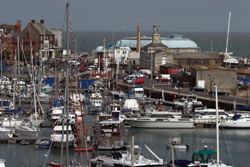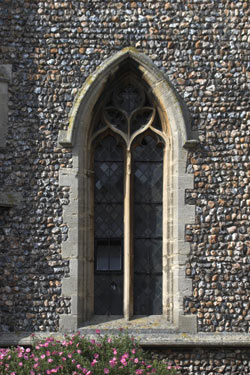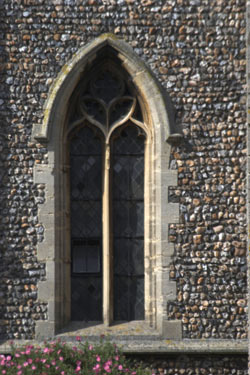Canon 100-400mm L IS USM
This is Canon’s longest zoom lens and is categorised as one of their L range. The lens has been around for some time now, earning itself a somewhat mixed reputation amongst digital photographers that didn’t arise in the days of film. We take a look at this phenomenon.
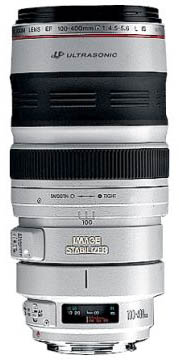 Specification
Specification
- Focal length 100-400mm
- Aperture f/4.5-5.6
- Closest focus 1.8m
- Construction 17/14 elements/groups
- Filter 77mm
- Dimensions 92x189mm
- Weight 1.38kg
- Hood ET-83 (supplied)
- Price (SRP) £1199.99p
Build and handling
This lens is one of the ‘big white’ lenses from the Canon range but is almost unique in that it retains the old ‘one touch zoom’ mechanism that was popular in the late 70’s and early 80’s. This means that you can push/pull the front part of the barrel to change the focal length at the same time as turning it to adjust the focus manually. Unfortunately, this mechanism has been blamed in part, by digital snappers, for sucking dust into the camera and therefore contaminating sensors, a problem that never showed up on film due to the surface of the film constantly changing.
One slightly more genuine problem of this design is that of the bearings on which the zoom action relies giving up and jamming up the whole mechanism, necessitating a trip to the service agents. More than their fair share of these lenses seems to have suffered the problem over time. And that appears to be the main concern over this lens, that it is becoming rather long in the tooth. Despite improvements, notably to the IS system in later models, the design leaves a few problems that do not occur in more modern lens designs.
Manual focus, for example, is achieved with a ring that is a long way from the camera body when the lens is extended to its full focal length.
Having said all that, the lens is still well built and finished with the now famous white enamel and when working is smooth in all its workings. Autofocus, although not lightning, is quick enough for most purposes and almost silent in operation. The whole lens has a business like feel to it, being solid but not too overbuilt. It does, however, seem to move slightly in the mount and this can cause modern cameras to show faults occasionally.
Optical quality
Having tested more than one example of this optic, the performance can only be described as variable. This again is probably due to the design, where a sliding mechanism is not capable of keeping the elements perfectly aligned, especially as the lens gets older.
Colour reproduction and contrast, as with virtually all of Canon’s L series lenses, is good with a slightly warm rendition. Distortion also, is well sorted, although this is not normally a problem on this length of lens and, as expected, the figures were not significant. The variability was in the resolution figures where lenses differed by significant margins. With all the tested examples, and quite normal for this focal range, the results were better at the shorter end than at the longest focal settings.
In practice, when new, the lens is an improvement from the general group of 70-300mm lenses that many users will be upgrading from and the reputation that the lens has acquired is, for the most part, well deserved. It is only with the higher demands of digital capture, where everything gets inspected at 100% or more that some aspects of the design have come into question. Having said that, the example supplied by Canon for this test, serial number 200225, showed poor resolution even to the naked eye. There are also some CA problems with this particular optic.
 The lens has a useful focal range for such things as ‘captive wildlife’ in zoos, such as these two shots from the BWC. |  It is also popular in other disciplines requiring longer focal lengths although it is a little slow to use in fast moving sports. |
 | With a close focus distance of a useful 1.8m, the lens works at close distances and can be used with extension tubes as here where a 12mm one was fitted. |
Click on each comparision photo below to view full size versions
Below is our lens test data. To find out how to use these graphs look at this article: How we test lenses
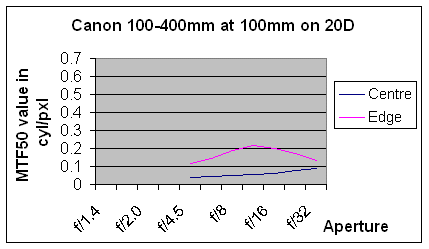
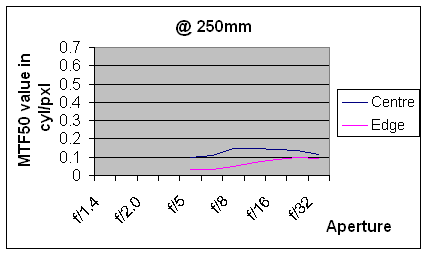
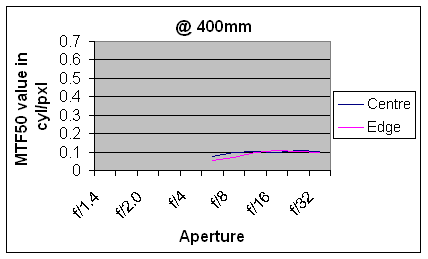
Verdict
A popular lens that that is superficially well built but has a few quirks and an Achilles heel in the bearing problem. It is probably worth buying any extended warranty that is offered with it. If you get a good one it is well worth hanging on to but be aware of the known problems when buying second-hand where there is a healthy market.
Check the findings from the earlier tests in the article here
Probably the Canon lens most in need of updating now that the digital age is here to stay.
In summary, the positive points of the Canon 100-400mm L IS USM are:
![]() Good contrast and colour.
Good contrast and colour.
![]() Good AF speed that is quiet in use.
Good AF speed that is quiet in use.
![]() Nice focal range at acceptable 3:1 ratio
Nice focal range at acceptable 3:1 ratio
![]() Holds its value well
Holds its value well
The negative points are:
![]() Awkward manual focus at longer focal lengths
Awkward manual focus at longer focal lengths
![]() Known problem with bearings giving up the ghost
Known problem with bearings giving up the ghost
![]() Wear in the bearings may well cause deterioration in performance.
Wear in the bearings may well cause deterioration in performance.
![]() May drag dust into the sensor.
May drag dust into the sensor.
Check the latest price of the Canon 100-400mm L IS USM here
Test by Ian Andrews www.wildaboutkent.com
Tests carried out on a Canon 1D
http://mypalm.ath.cx/enigma/index.php?topic=893.msg3983;topicseen#msg3983
Like all such lenses, performance drops off rapidly at the smallest apertures due to diffraction. This however, is only to be expected.
The push/pull zoom action does provide room for bearing wear in lenses used for heavy pro use, but for most users this shouldn't be an issue until many years use have been put under the belt.
A great lens.
I got this lens to supplement the 28-135 IS, but I've ended up rarely using it. In fact, Ive decided that there may be a better choice for many photogs.
First let me begin by stating the obvious. Most images taken with this lens here and on online galleries like photosig or photo*net are taken at 400mm. Duh! I was hunting last weekend and took this lens along shooting animal pics from a blind. I set it to 400 and left it there. For wildlife and landscape shooters in particular, if the lens is going to be used at 400mm practically all the time, I think a better choice might be the 400mm 5.6 prime- costs hundreds less and sharper to boot. Going a step further, one sucessful wildlife photog I know recommends that if you are thinking about shooting wildlife other than birds, forego 400mm(prime or zoom)and get the 300mm F4 prime. His opinion: the larger size of most mammals offsets the loss of that last 100mm, yet is sharper, has lower light perfomance for the times of day when most mammals start moving, and yes, less money.
More Detail : http://webcamerawebcamera.com/detail.php?id_detail=Canon-EF-100-400mm-f4-5-5-6L-IS-USM-Telephoto-Zoom-Lens-for-Canon-SLR-Cameras-id19a&template=2
Add your message
Please login here or if you've not registered, you can register here. Registering is safe, quick and free.
photodo Stats
428 MTF tests
74 in-depth photodo reviews
100+ users join each day
Help the lens community by reviewing or rating a lens today via our lens search
Latest Lens Reviews
- Chinon 28mm f/2.8 Vintage Lens Review
- Canon EF 70-200mm f/4L IS II USM Lens Review
- Samyang AF 85mm f/1.4 EF Review
- Sigma 70mm f/2.8 DG Macro Art Review
- Samyang AF 24mm f/2.8 FE Review
- Meike 50mm f/1.7 Review
- Tamron 70-210mm f/4 Di VC USD Review
- Lensbaby Burnside 35mm f/2.8 Review
- Asahi Super Takumar 50mm f/1.4 Review
- Asahi Super-Multi-Coated Takumar 135mm f/3.5 Review
